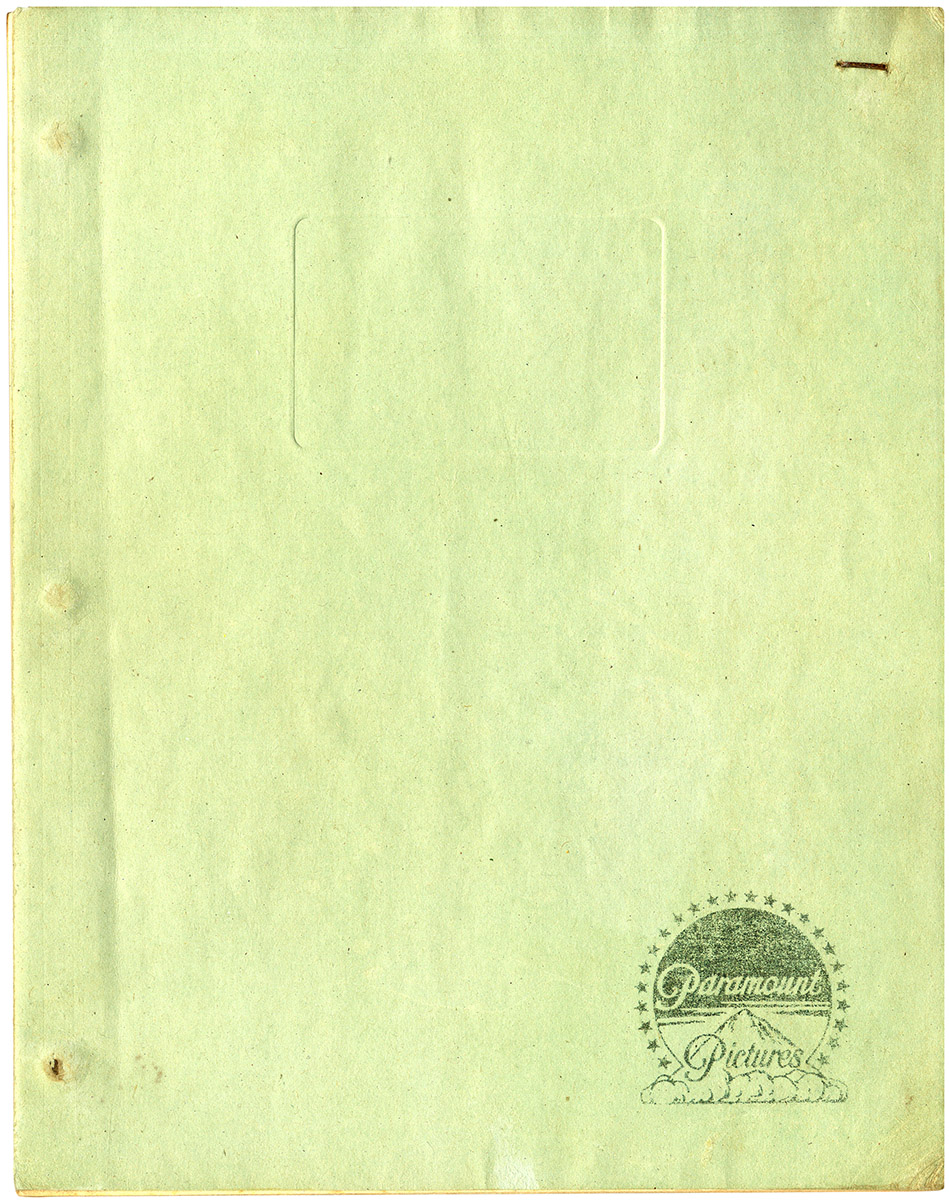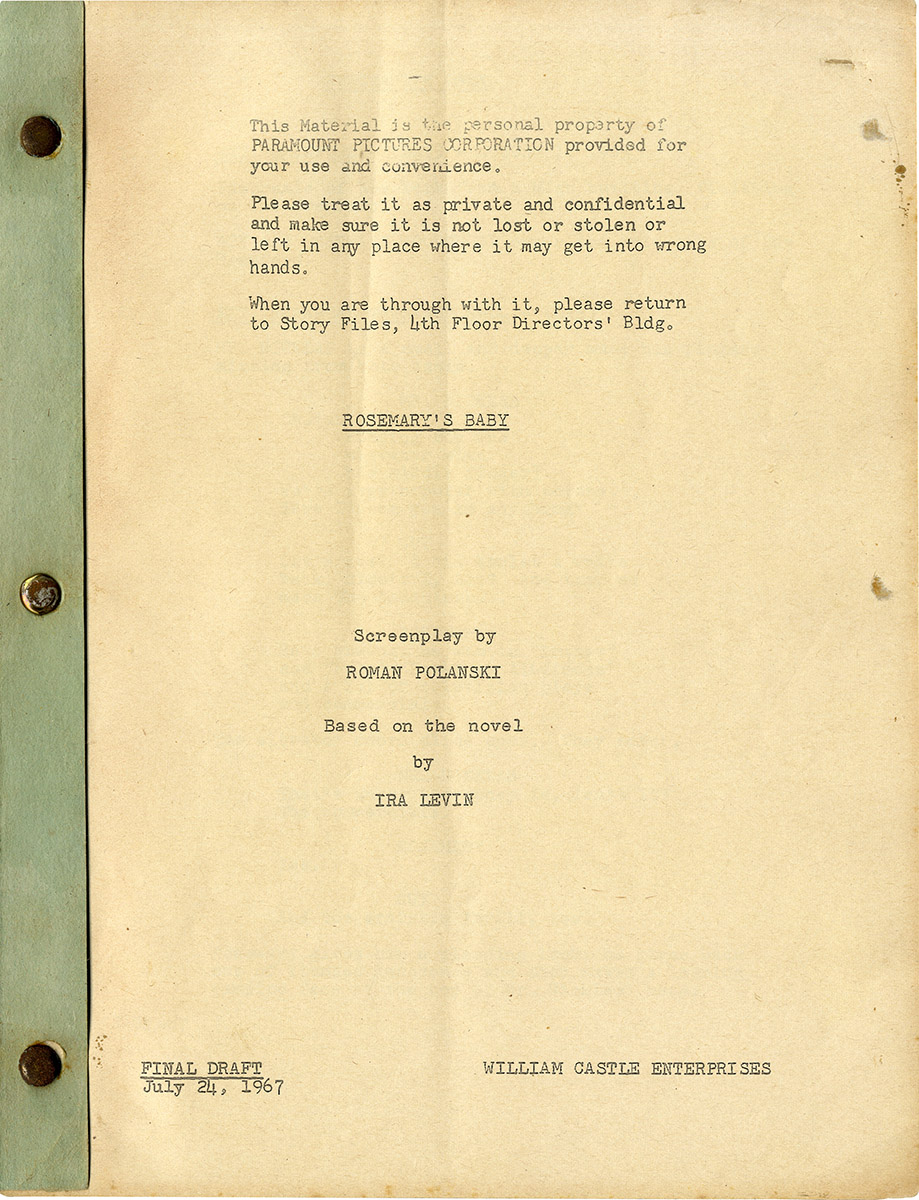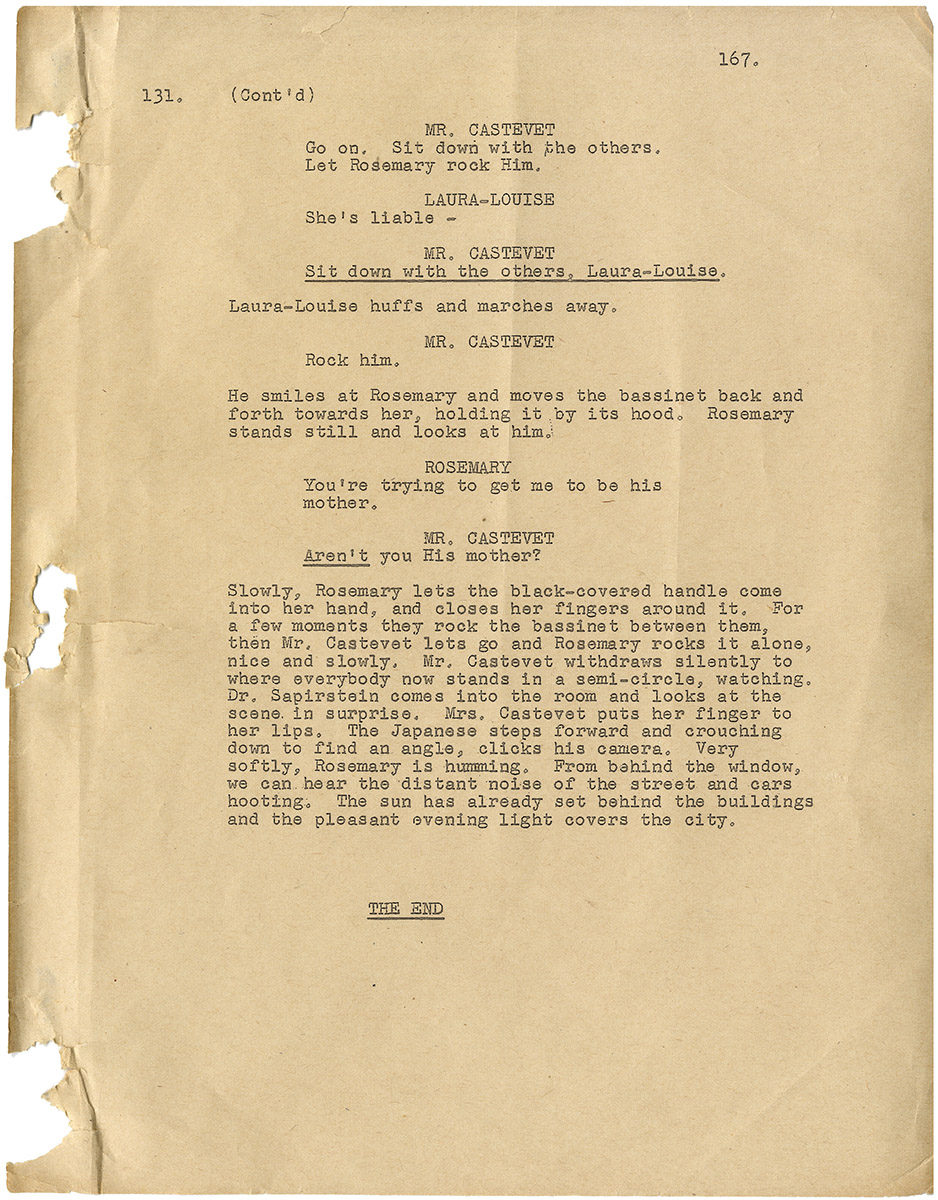Roman Polanski (screenwriter, director) ROSEMARY’S BABY (Jul 24, 1967) Final Draft screenplay
Hollywood: Paramount Pictures, 1967. Vintage original film script, 11 x 8 1/2″ (28 x 22 cm.), dated July 24, 1967. Printed studio wrappers, 167 pp. (pp. 91 and 92 were not bound into this script). Lacks back blank wrapper, brad bound, final page coming loose (but present), overall very good+.
Based on a best-selling novel by Ira Levin, the film rights to Rosemary’s Baby were purchased by Paramount studio head Robert Evans, at the request of producer William Castle (House on Haunted Hill, The Tingler) while the book was still in galleys form. Castle famously wanted to direct the movie himself, but studio head Evans — who saw this project as an A-picture and viewed Castle as a director of B-films — insisted on hiring Roman Polanski, whose European work he had admired, to direct instead.
The Final Draft screenplay and the film made from it give Polanski sole credit for adapting Levin’s book, but, in fact, Polanski worked quite closely with his production designer, Richard Sylbert, on the adaptation. Sylbert helped make sure that the New York characters sounded like New Yorkers, and was instrumental in the choice of filming locations. It was Sylbert who suggested using New York’s iconic Dakota Apartments for exterior shots of the novel’s fictional Bramford Building.
The story is about a young woman, Rosemary Woodhouse (Mia Farrow), living in Manhattan with her actor husband, Guy (John Cassavetes), who gets pregnant, and comes to believe that the people around her — including elderly neighbors Roman and Minnie Castevet (Sidney Blackmer and Ruth Gordon), and maybe her own spouse — are plotting to use her baby in some kind of Satanic ritual. From virtually the time of its release through the present, Rosemary’s Baby has been considered a horror classic in the tradition of such woman-centered horror films as Val Lewton’s Cat People and The Seventh Victim (the latter film’s story of devil worshippers in Manhattan anticipating Rosemary’s Baby by 25 years).
Viewed as a film by Roman Polanski, Rosemary’s Baby (1968) can be seen as the second in a trilogy of movies about people slowly going mad in enclosed apartments. Repulsion (1965), a British film starring Catherine Deneuve, was the first film in Polanski’s Apartment Trilogy. The Tenant (1976), starring Polanski himself, was the third. Polanski received Oscar and Golden Globe nominations for his screenplay adaptation, while Ruth Gordon won at both ceremonies for Best Supporting Actress.
The extraordinary box office success of Rosemary’s Baby can be attributed to several factors. Its subject matter touched on contemporary anxieties relating to the rise of feminism and the fear of children at a time when young people were demonstrating against the Vietnam War while experimenting with drugs, the occult, and other alternative lifestyle practices. Universal fears pertaining to pregnancy also played their part. On top of that, Rosemary’s Baby succeeded as a very effectively written and directed horror film grounded in reality by a uniformly excellent cast.
Polanski’s Final Draft screenplay of Rosemary’s Baby is 167 pages long. The completed film runs 137 minutes, so clearly some dialogue and sequences had to be cut. What remains is very close to the released film. Even Cassavetes’ sardonic wisecracks, though they seem improvised, can be found verbatim in Polanski’s screenplay.
There were, however, various sequences in the script which were not in the final cut of the film:
- Rosemary meets a friend named Joan in a café and tells her they have just rented an apartment in the Bramford. Joan is envious.
- Rosemary and Joan go shopping for apartment furnishings.
- In the movie, Rosemary meets a young woman, Terry, in the apartment’s laundry room who is staying with the Castevets and who later commits suicide. The screenplay includes an additional scene where Rosemary introduces Terry to Guy.
- A scene where Rosemary meets another tenant, a two-year-old girl.
- Rosemary in a taxi with a girlfriend talking about Guy’s reluctance to have a baby at this time and how Rosemary might trick him into it.
Some of the characters are described differently in the screenplay than they appear in the film. In the screenplay, Minnie Castevet is described as a large woman with a “loud Midwestern accent” (Guy compares her to Ma Kettle). In the movie she is played by Ruth Gordon, a petite actress whose accent is decidedly New York Jewish. In the screenplay, the character who shows Rosemary and Guy the apartment is described as having “fingers missing from both hands.” This is not apparent in Elisha Cook’s screen performance as that character.
One of the few scenes that wasn’t filmed exactly as scripted is the mid-story dream sequence where Rosemary is impregnated by the devil. Some details are changed, others added, for example, the presence of John F. and Jacqueline Kennedy on Rosemary’s dream yacht.
Notwithstanding its reputation as one of the greatest horror movies of all time, Rosemary’s Baby can also be read as a black comedy. The last scene, in particular, is a macabre parody of the Christian Nativity, with its upside-down cross, Rosemary and Guy as Mary and Joseph, and the devil worshippers with their gifts to the baby standing in for the three Wise Men. One thing in the screenplay that is missing from the film is the indication of specific dates for each sequence. Thus, another hidden joke, the baby is born in June 1966, alternatively stated, 6-6-6.
Out of stock
Related products
-
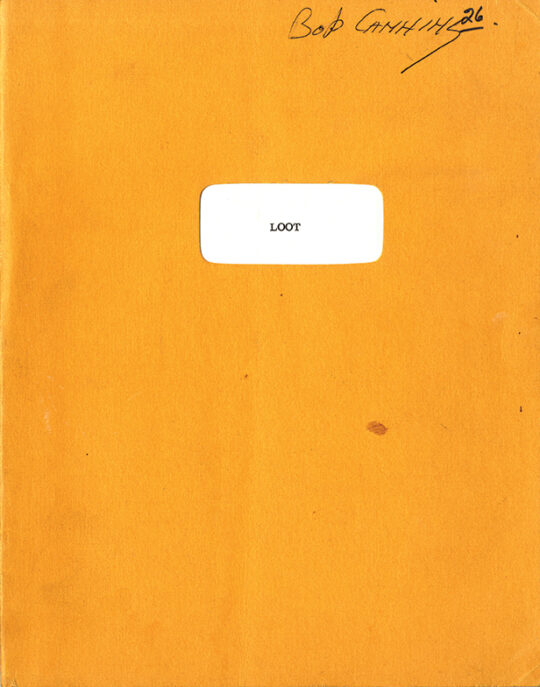
LOOT (ca. Sep 1969) Final Draft screenplay
$1,500.00 Add to cart -
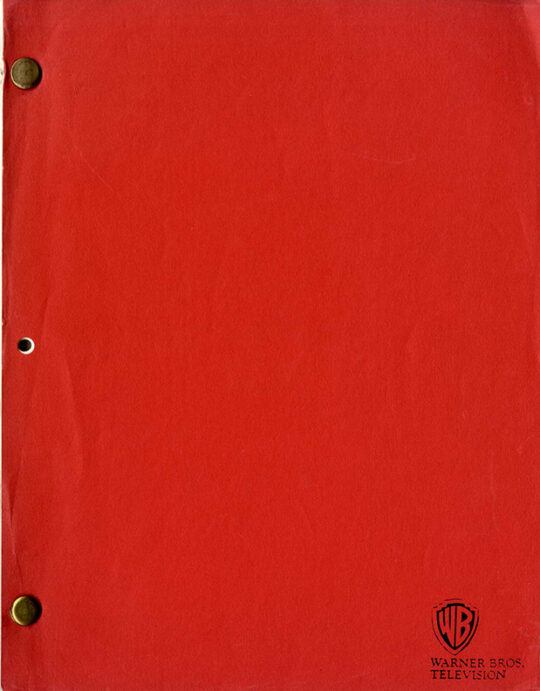
DRESS GRAY (Mar 6, 1981) Second revision script by Gore Vidal
$500.00 Add to cart -
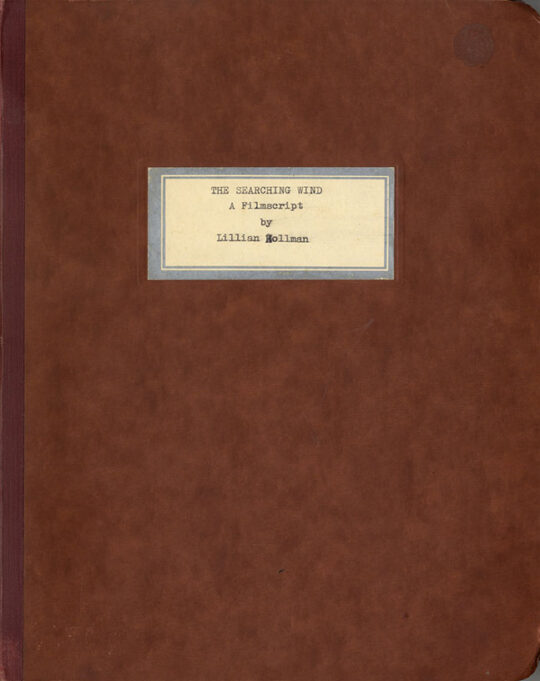
SEARCHING WIND, THE (Nov 7, 1946) Final White script by Lillian Hellman
$1,500.00 Add to cart -
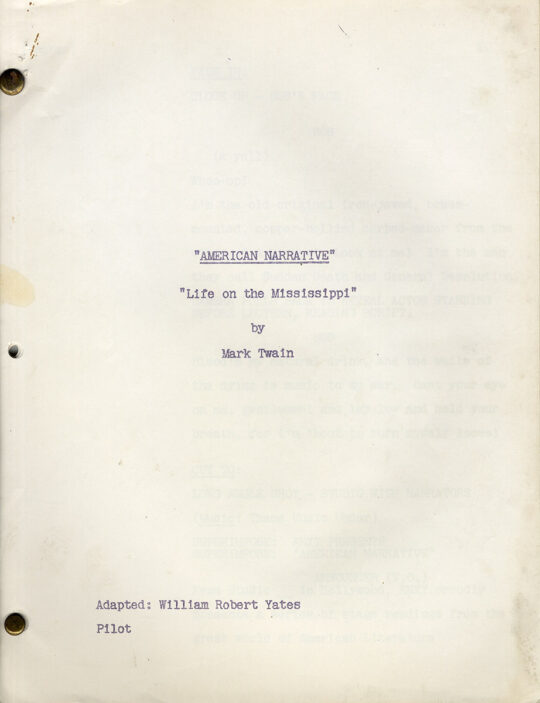
Mark Twain (source) LIFE ON THE MISSISSIPPI (ca. 1956) TV script adapted by William Robert Yates
$300.00 Add to cart

